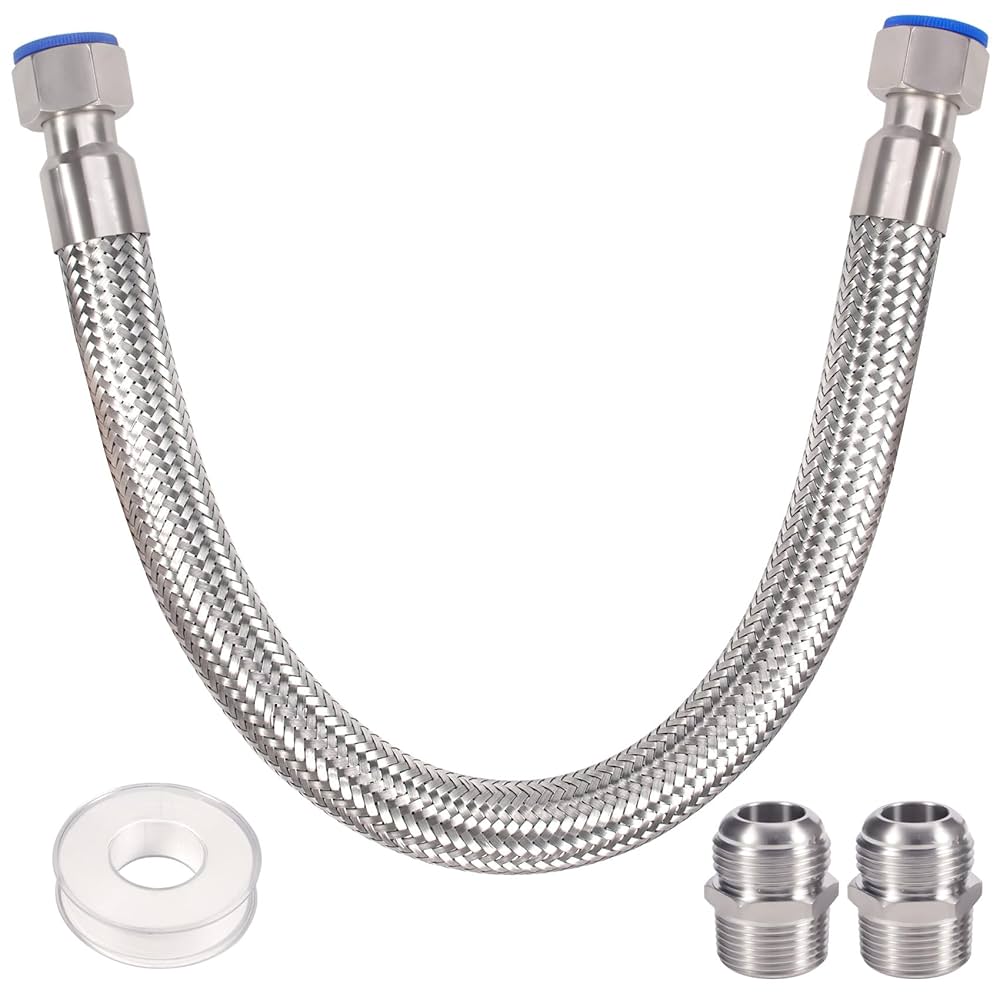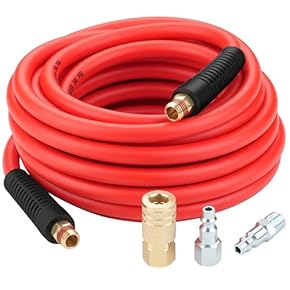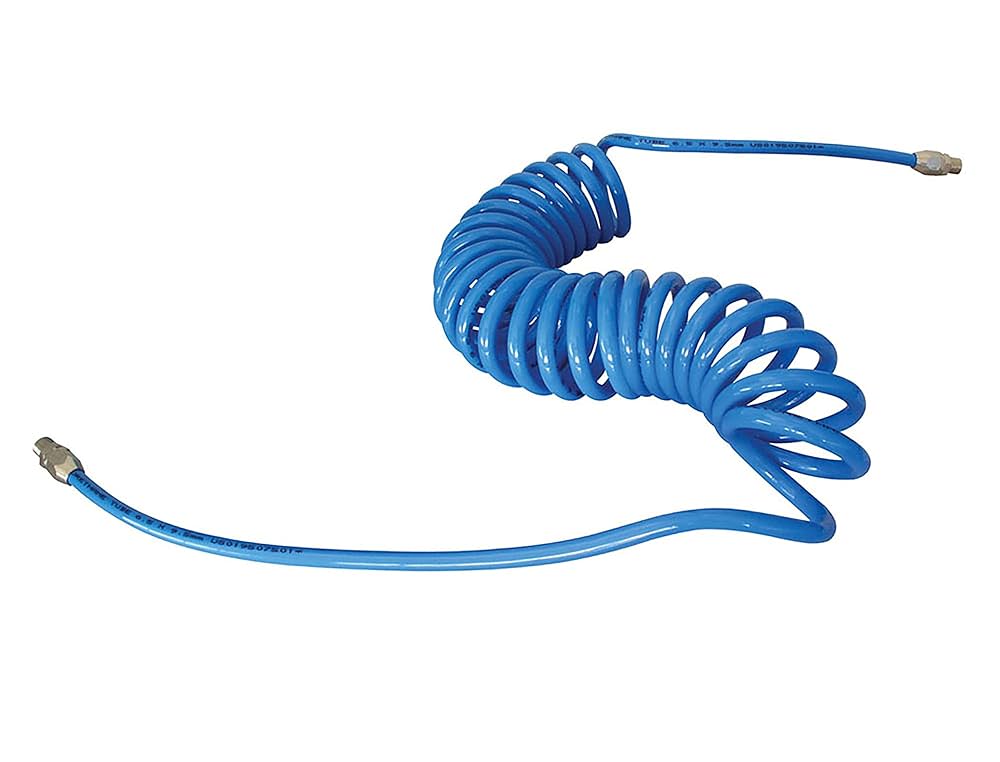When it comes to getting the most out of your air compressor, the right hose can make all the difference. You might think any hose will do, but choosing the perfect one can boost your tool’s performance and keep you safe.
Whether you’re tackling a big project or just need reliable equipment for everyday tasks, understanding what makes a great air compressor hose is key. You’ll discover how to pick the hose that fits your needs, saves you time, and protects your investment.
Ready to find out what your air compressor has been missing? Keep reading.

Credit: www.amazon.ca
Types Of Air Compressor Hoses
Choosing the right air compressor hose is important for safety and performance. Different types suit different jobs and environments. Knowing each type helps you pick what fits your needs best.
Rubber Hoses
Rubber hoses are strong and flexible. They handle high pressure well. These hoses resist wear from heat and rough surfaces. They stay soft in cold weather. Rubber hoses work well for heavy-duty tasks.
Pvc Hoses
PVC hoses are lightweight and affordable. They are easy to coil and carry. These hoses resist chemicals and moisture. PVC hoses do not stretch much. They are good for light or medium jobs.
Hybrid Hoses
Hybrid hoses combine rubber and PVC features. They offer both strength and lightness. These hoses resist kinks and twists. Hybrid hoses last longer than pure PVC. They suit many different work conditions.
Thermoplastic Hoses
Thermoplastic hoses are very flexible and clear. They resist oil and chemicals well. These hoses are lighter than rubber ones. Thermoplastic hoses are easy to clean. They work best in tight spaces and for precision tasks.

Credit: www.amazon.ca
Key Features To Consider
Choosing the right hose for your air compressor improves performance and safety. Different hoses have unique features. Knowing key features helps you pick the best one for your needs.
Durability And Strength
Hoses must resist wear and tear from daily use. Strong materials like rubber or reinforced PVC last longer. Look for hoses with tough outer layers that protect against cuts and abrasion. A durable hose saves money by lasting many years.
Flexibility And Weight
Flexible hoses bend easily without kinking or cracking. Lightweight hoses reduce user fatigue during long jobs. Flexible and light hoses improve comfort and ease of use. They also allow better movement around tight spaces.
Pressure Ratings
Every hose has a maximum pressure it can handle. Check the pressure rating to match your air compressor’s output. Using a hose with too low pressure can cause bursts or leaks. A proper pressure rating ensures safe and efficient work.
Temperature Resistance
Air compressor hoses face hot and cold conditions. Choose hoses that tolerate wide temperature ranges. This prevents damage from heat or freezing. Temperature-resistant hoses work well outdoors and in different seasons.
Choosing The Right Hose Length And Diameter
Choosing the right hose length and diameter is key for air compressor efficiency. The hose must fit your workspace and air tool needs. Wrong hose size lowers performance and wastes energy. This section explains how to pick the best hose length and diameter for your setup.
Impact Of Hose Length
Long hoses reduce air pressure at the tool. This causes slower tool operation and less power. Keep hoses as short as possible for best airflow. If longer hoses are needed, expect some pressure loss. Choose quality hoses that resist kinking to keep air flowing well.
Selecting The Correct Diameter
Hose diameter affects how much air flows through it. Small diameters limit airflow and reduce tool speed. Large diameters allow better air delivery but can be heavy and less flexible. Match the hose diameter to your air compressor and tools. Check the tool’s air requirements for the right size.
Fittings And Connectors
Fittings and connectors are crucial for air compressor hoses. They join hoses to tools, machines, and compressors. Good fittings ensure strong, safe, and leak-free connections. Choosing the right type and material prevents problems and keeps the system efficient.
Common Types
Quick-connect fittings are popular for easy tool changes. They snap on and off without tools. Threaded fittings screw tightly for a secure hold. Push-to-connect fittings allow fast hose attachment. Each type suits different tasks and needs.
Materials And Compatibility
Fittings come in brass, steel, and plastic. Brass resists rust and works well with air. Steel offers high strength for heavy use. Plastic is light but less durable. Match fitting material to hose and tool for best results.
Ensuring Leak-free Connections
Tighten fittings properly to avoid air leaks. Use thread seal tape on threaded connections. Check for damage or wear before use. Replace worn parts to keep the system sealed. Leak-free fittings save energy and improve performance.
Maintenance And Care Tips
Proper maintenance and care keep your air compressor hoses working well. It helps avoid leaks and breaks. Regular checks and cleaning make sure hoses last longer.
Cleaning And Storage
Clean hoses after each use. Wipe dirt and dust off with a damp cloth. Avoid harsh chemicals that can damage the hose material.
Store hoses in a cool, dry place. Coil them loosely to prevent kinks. Keep away from sharp objects and direct sunlight.
Inspecting For Wear And Damage
Check hoses often for cracks, cuts, or bulges. Look for leaks by feeling for air escaping. Replace hoses that show signs of damage.
Inspect fittings and connectors too. Tighten loose parts to avoid air loss. Damaged fittings can cause poor performance.
Extending Hose Lifespan
Use hoses only for their intended purpose. Avoid stretching or bending them sharply. Protect hoses from extreme temperatures and chemicals.
Drain moisture from hoses after use. Moisture can cause rust and damage inside the hose. Regular care keeps hoses safe and effective.

Credit: www.amazon.ca
Safety Considerations
Safety is the top priority when using hoses for air compressors. These hoses carry high-pressure air that can cause serious injury if not handled properly. Understanding safety rules helps prevent accidents and damage to equipment.
Follow basic guidelines to keep yourself and others safe. Inspect hoses often and replace damaged ones. Use the right hose for the job to avoid risks.
Handling High Pressure
Air compressor hoses hold strong pressure. Always check the hose’s pressure rating before use. Never exceed the maximum pressure limit. Secure connections tightly to stop air leaks. Keep hands and body parts away from hose ends during operation. Sudden bursts can cause harm.
Avoiding Kinks And Twists
Kinks and twists block air flow and weaken hoses. Straighten hoses before use. Coil hoses loosely to prevent sharp bends. Avoid dragging hoses over rough surfaces. Replace hoses with permanent kinks to avoid failures. Proper hose storage extends life and maintains safety.
Protecting Against Abrasion
Hose abrasion wears down material and causes leaks. Use protective sleeves or guards in high-friction areas. Keep hoses away from sharp edges and hot surfaces. Regularly check for worn spots or cuts. Replace hoses showing signs of abrasion to avoid accidents.
Top Brands And Product Recommendations
Choosing the right air compressor hose matters for both performance and safety. Top brands offer quality, durability, and reliability. Here, find trusted brands and recommended products that suit different budgets and needs. Each option ensures efficient air flow and long-lasting use.
Budget-friendly Options
For those on a budget, some brands deliver solid performance without high costs. Goodyear’s air hoses offer durability and flexibility at affordable prices. Another good choice is Flexzilla, known for lightweight and kink-resistant hoses. These options work well for DIY projects and occasional use.
Premium Choices
Premium hoses provide extra strength and longer life. Milton and Campbell Hausfeld make hoses with excellent materials that handle high pressure. These brands often include features like crush-proof fittings and superior abrasion resistance. Ideal for professionals and heavy users needing reliable performance.
Specialty Hoses
Specialty hoses serve unique purposes and environments. For example, polyurethane hoses resist chemicals and cold temperatures. PVC hoses are lightweight and ideal for indoor use. Brands like Maxline specialize in these types, ensuring the hose matches the job’s specific needs.
Common Problems And Troubleshooting
Air compressor hoses are essential for many tasks. Problems with hoses can stop work and cause frustration. Knowing common issues helps fix them fast. This saves time and money. Understanding troubles makes your work smoother and safer.
Leaks And Punctures
Leaks happen when hoses get small holes or cracks. These let air escape and reduce pressure. Check hoses regularly for cuts or worn spots. Use soap water to find tiny leaks. Tighten fittings to stop leaks around connections. Replace hoses if damage is too big.
Pressure Loss Issues
Pressure loss means the air flow is weaker than normal. This happens if the hose is too long or kinked. Dirt inside the hose can also block air flow. Avoid sharp bends and keep hoses clean. Use the right hose size for your compressor. Fix or replace hoses causing pressure problems.
Hose Compatibility Problems
Not all hoses work with every air compressor. Using wrong hoses can cause leaks or damage. Check the hose’s pressure rating before buying. Match the hose material to the job type. Some hoses resist heat or chemicals better. Choose hoses designed for your compressor model.
Frequently Asked Questions
What Types Of Hoses Work Best For Air Compressors?
Air compressor hoses come in rubber, PVC, and hybrid types. Rubber hoses offer flexibility and durability. PVC hoses are lightweight and cost-effective. Hybrid hoses combine strength and flexibility, ideal for various applications. Choose based on your needs and environment.
How To Choose The Right Air Compressor Hose Size?
Select hose size by matching the compressor’s CFM and tool requirements. Larger diameter hoses offer better airflow but can be heavier. Common sizes are 1/4, 3/8, and 1/2 inches. Correct size ensures optimal performance and reduces pressure loss.
Can Air Compressor Hoses Handle High Pressure?
Yes, most air compressor hoses are rated for high pressure. Always check the PSI rating on the hose. Using a hose with a lower rating than your compressor’s pressure can be dangerous. Safety and compatibility are essential.
How To Maintain Air Compressor Hoses For Longevity?
Regularly inspect hoses for cracks, leaks, or wear. Store hoses away from direct sunlight and extreme temperatures. Avoid kinking or twisting the hose during use. Proper maintenance extends hose life and ensures safety.
Conclusion
Choosing the right hose keeps your air compressor working well. Strong, flexible hoses last longer and save money. Check the hose size and material before buying. A good hose makes your tasks easier and safer. Keep hoses clean and inspect them often.
Small steps can prevent big problems later. Use hoses that match your compressor’s power and pressure. This helps tools work better every time. Remember, a quality hose improves your whole setup. Simple care and smart choices lead to better results.

